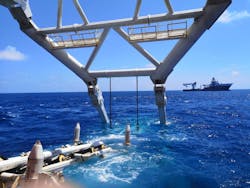Cortez Subsea and partner Alam Maritim have completed their first subsea pipeline project involving use of the Zap-Lok mechanical connector offshore Malaysia.
During the subsea pipelay campaign the highest average lay rate was 4.7 km (2.9 mi) in 24 hours, and the rigid pipelay section was completed within 20 days. This rate is faster than the conventional welded pipelay approach, Cortez claimed, and led to cost savings for the project.
Petronas subsidiary Vestigo Petroleum developed the 12-in, 68-km (42-mi) pipeline system for the Tembikai Non-Associated Gas development. It employs NOV-Tuboscope Zap-Lok connectors to link the rigid pipeline via diverless connections.
Cortez’s office in Kuala Lumpur managed the work scope, which included engineering, procurement, construction, installation, and pre-commissioning of the pipeline system.
Alasdair Cowie, managing director of Cortez Subsea, said: “In another industry first, the rigid pipe was connected to flexible risers using a stinger-deployed diverless connector, which we brought to the market in partnership with AFGlobal. Using an ROV and a deployment frame, the connection is made from the pipeline to the host facility without the use of divers.
“A complete diverless approach reduces cost and increases safety for the team offshore and this mechanical alternative to welding results in a safer work environment, which is free from hot-work and radiography.”
Based on AFGlobal’s proven Retlock clamp technology, the stinger-deployed diverless connector system is said to help operators achieve a 20% cost reduction compared to conventional diver installation.
Saipem, TechnipFMC secure Petrobras contracts
Petrobras has contracted Saipem to install a rigid riser-based subsea system for the latest phase of the Búzios field development in the presalt Santos basin offshore Brazil. Water depths range from 1,537-2,190 m (5,042-7,185 ft).
The Búzios-5 production system will involve connection of 15 wells to the FPSO in two phases. Under an EPCI contract, Saipem will supply and install the steel lazy wave risers and associated flowlines between all the wells and the FPSO.
Its scope of work will include five production and five injection risers and flowlines, with a total length of 59 km (36.7 mi); a 16-km (9.9-mi) long gas export line to be connected to an existing pipeline; 11 rigid jumpers; and 21 foundation subsea structures (risers and pipeline end terminations).
Saipem will deploy its construction vessel FDS for all the subsea activities.
The company has awarded TechnipFMC an EPCI contract on behalf of the Libra consortium for the presalt Mero 2 project in the Santos basin offshore Brazil. Water depth is 2,100 m (6,890 ft).
The work scope comprises engineering, procurement, construction, installation and pre-commissioning of the infield rigid riser and flowlines for production, including the water alternate gas wells; and installation and pre-commissioning of service flexible lines and steel tube umbilicals, plus towing and hook-up of the FPSO.
TechnipFMC plans to adopt synergies with its subsea EPCI work for Mero 1, using its own rigid and flexible lay vessels and its local facilities in Brazil, including a spoolbase, logistics base and other engineering capabilities.
Offshore construction is due to start in 2022.
Petronas joins multi-phase pump development
FASTsubsea and Petronas Research Sdn Bhd have signed a joint industry project contract to develop and test a low-cost, topsides-less subsea multi-phase pump. FASTsubsea is a joint venture between Aker Solutions and FSubsea.
According to the agreement, Petronas Research will support the development and testing program while FASTsubsea is bringing the product to the market in 2022.
Alexander Fuglesang, managing director of FASTsubsea, said the technology allows operators to more rapidly extract additional hydrocarbons from existing offshore wells and installed infrastructure. End users are drawn to the technology as increased recovery now can be done in a much more sustainable way, and at up to 50% lower capex investment than conventional subsea pumping systems.
The participation from Petronas Research comes in addition to a NOK 11-million ($1.2-million) commitment from the Research Council of Norway and allows engineering activities to start immediately.
The project is still open for two further operators to join as JIP partners.
About the Author
Jessica Stump
Editor
Jessica Stump is editor of Offshore Magazine. She uploads and writes news to the website, assembles surveys and electronic newsletters, and writes and edits articles for the magazine. She was the summer editorial intern at Offshore in 2009 and 2010 before joining full time in April 2011. She has a journalism degree from Texas Tech University.


